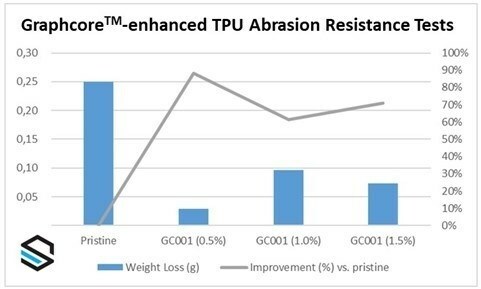
Black Swan Graphene’s product increases abrasion resistance in thermoplastic polyurethane
May 2, 2023 | By MRO staff
 Figure 1: Weight loss and abrasion resistance of TPU composites at different loading levels (Photo: CNW Group/Black Swan Graphene Inc)
Figure 1: Weight loss and abrasion resistance of TPU composites at different loading levels (Photo: CNW Group/Black Swan Graphene Inc) 
Figure 1: Weight loss and abrasion resistance of TPU composites at different loading levels (Photo: CNW Group/Black Swan Graphene Inc)
Black Swan Graphene Inc., latest version of its GraphCore 001 graphene nanoplatelet material (Graphcore) enhances the composite abrasion resistance by a range of 60 per cent to 80 per cent, when used as an additive in Thermoplastic Polyurethane (TPU).
The company had previously communicated an already enviable enhancement performance of 45 per cent in TPU with a one per cent loading ratio (amount of additive material added to a composite material, relative to the amount of matrix material).
TPU is a thermoplastic elastomer combining some properties of both plastic and rubber. It is flexible, durable, and resistant to abrasion as well as to oils and lubricants. This combination of properties makes TPU suitable for various applications including in automotive, sports equipment, textile coatings, and mobile handsets.
“Today’s performance results serve as a reminder that graphene could revolutionize the enormous polymer industry,” said Simon Marcotte, president and CEO, Black Swan Graphene. “In addition to improving abrasion resistance, graphene offers meaningful benefits such as weight reduction, cost savings, enhanced precision, improved gas permeability, and increased thermal conductivity, all of which can improve existing markets and pave the way for new applications.”
The manufacture of the composites, being the Graphcore-enhanced TPU, and the subsequent testing, were carried out independently at the Graphene Engineering Innovation Centre (GEIC) located at the University of Manchester, United Kingdom.
The precise type of TPU selected for the trials is currently used in mobile equipment and extruded sheets, which are generally used in many industries from packaging to transportation and construction materials. The composites were manufactured via a masterbatch and then moulded to carry out the tests, which were based on loading ratios of 0.5 per cent, one per cent, and 1.5 per cent.
The results, presented in the figure-1, show that all the Graphcore-loaded composites demonstrated improvements in performance compared to the pristine level.
The abrasion tests correspond to norm ISO 5470 – 1:2016 – Taber abrasion1. Three thousand (3,000) cycles were carried out using standard abrasive wheels with 1,000 grams of weight per wheel. The weight loss was recorded after each 1,000 cycles. Between each 1,000 cycles, the wheels were abraded with the standard sandpaper to 50 cycles; sandpaper was changed for the start of each new test.
The current plastic additive market (and not the plastic market itself) is estimated to be approximately USD $40 billion per year. In its 2021 report, The Graphene Council estimated that the potential annual graphene requirements, when combining all different types of polymers at a five per cent loading ratio, would be 12.5 million tons of graphene.
